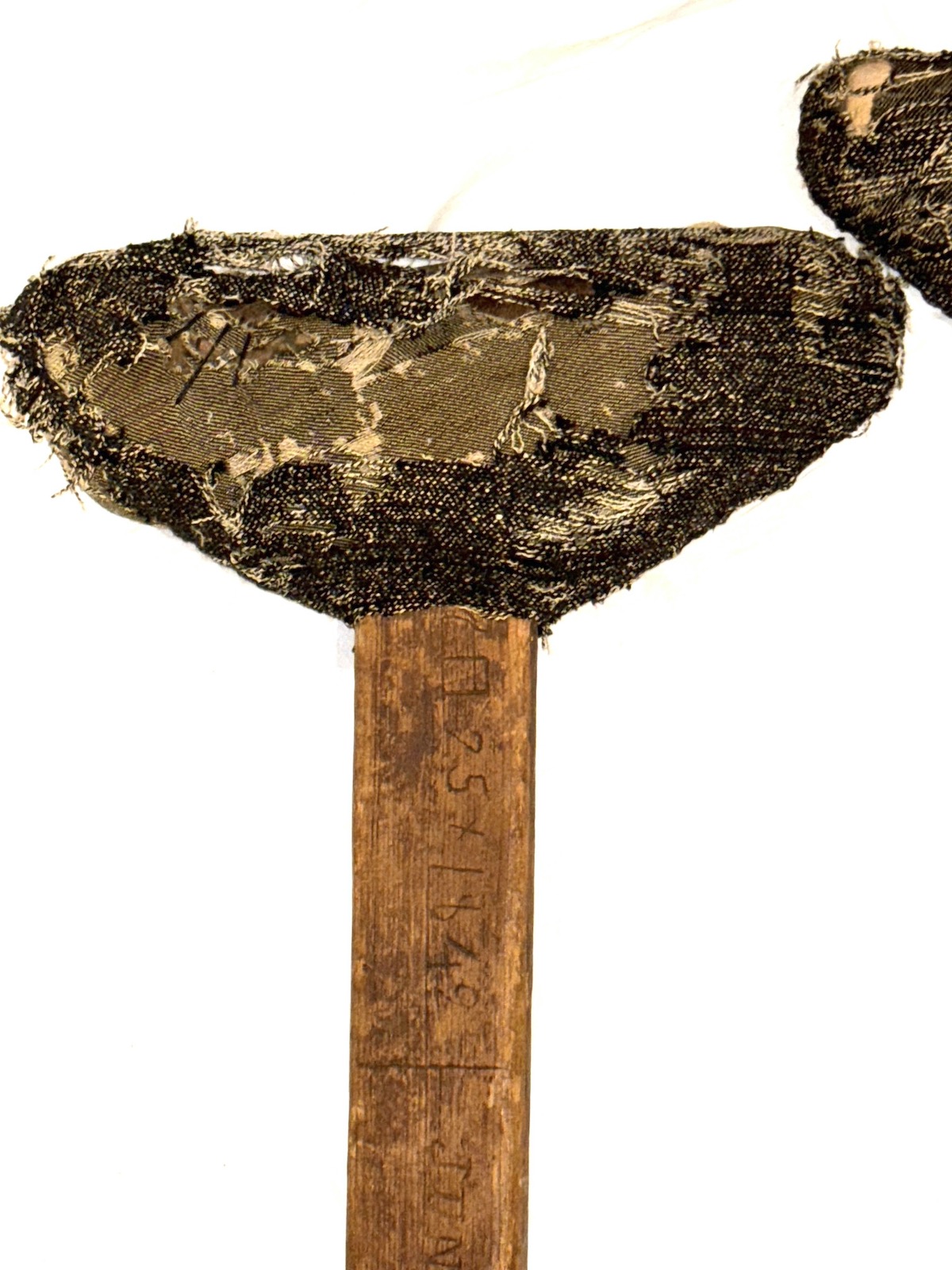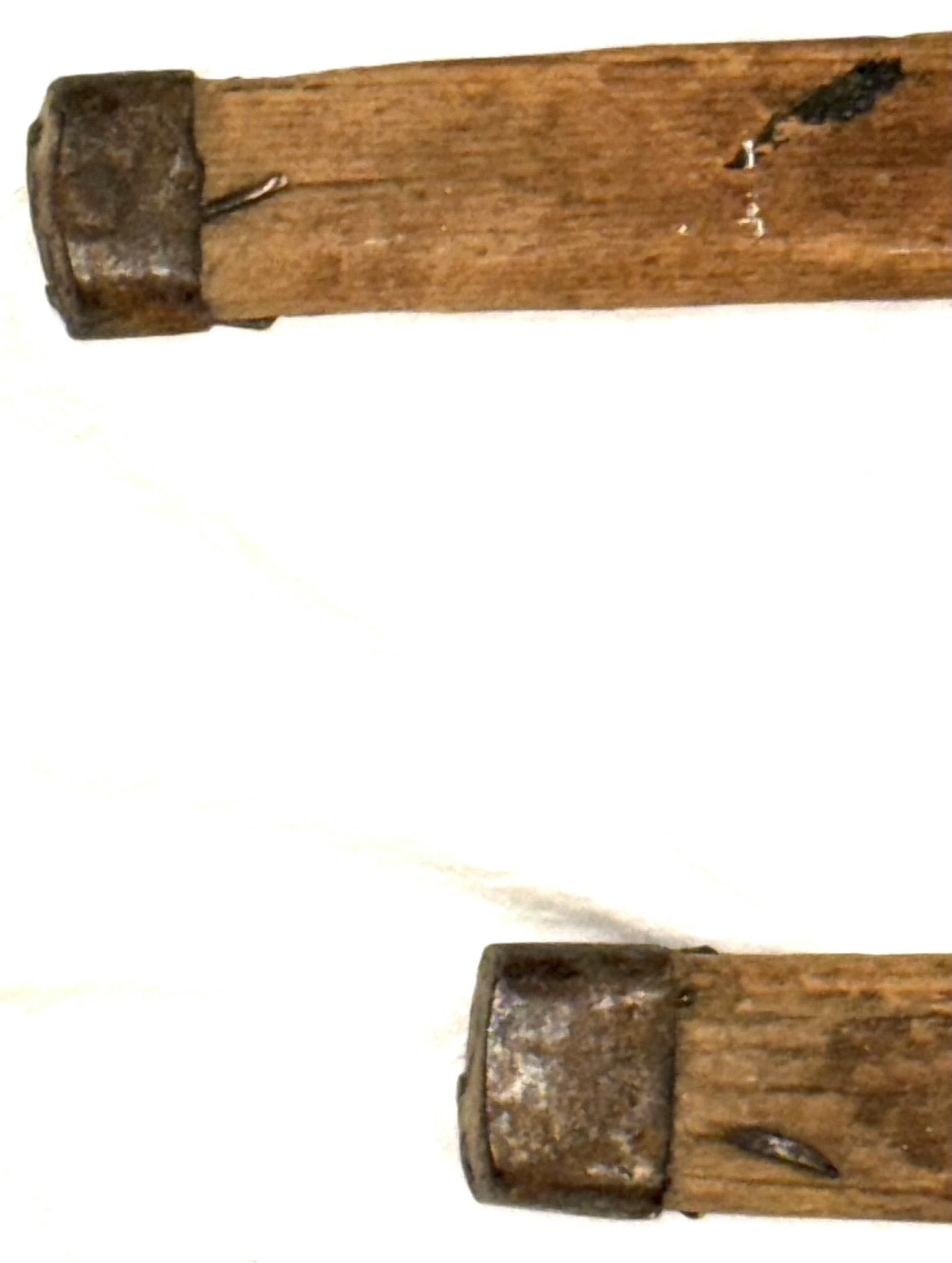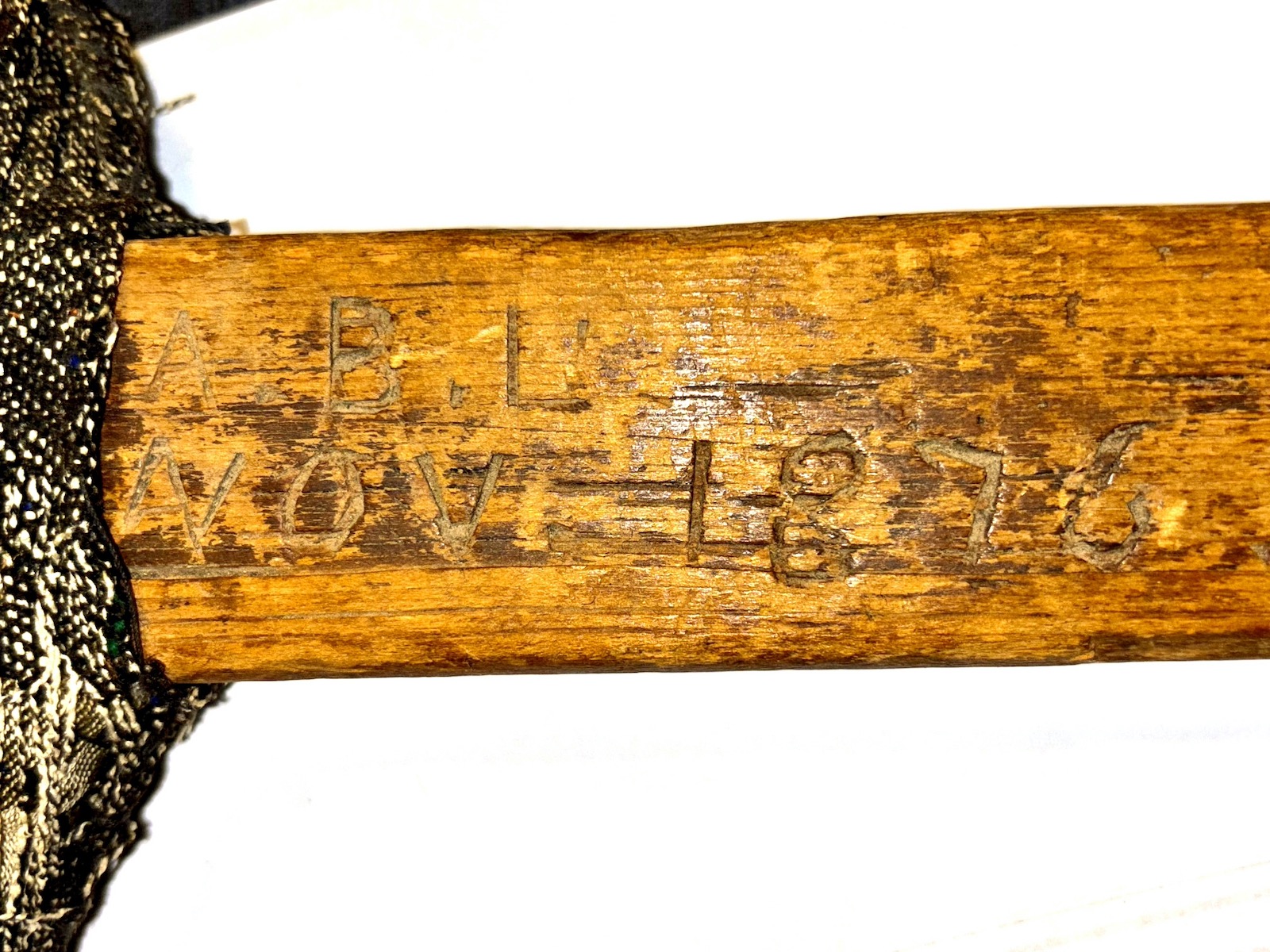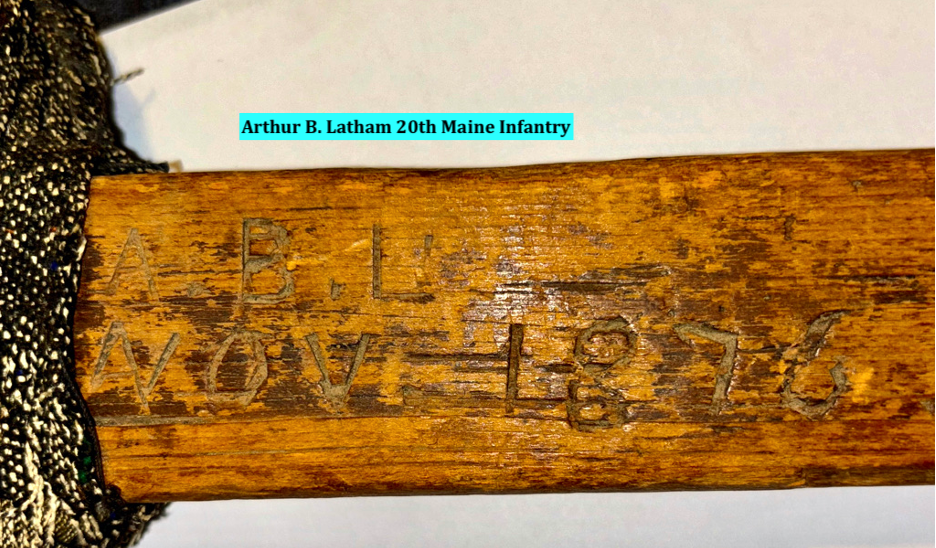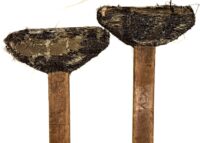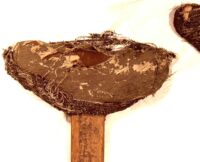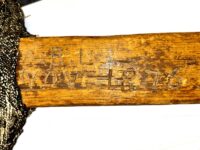Id’d Pair of Civil War Period Crutches – Multiple Names and Dates Carved into the Shafts of Each of the Pair
$1,250
Id’d Pair of Civil War Period Crutches – Multiple Names and Dates Carved into the Shafts of Each of the Pair – We have had or seen many Civil War crutches, attesting to the incredible number of casualties of the war, but this pair is the first we have seen or owned, that is a definitively war period pair of crutches that have multiple names and dates carved into the wooden shafts. Virtually all of the soldiers’ names were men who enlisted in regiments from the state of Maine; the dates are wartime, as well as postwar, perhaps carved during a veterans’ reunion. We have been successful in determining the identity of most of the names and those of the men who only put initials, although we have not been able to identify all, nor do we know the significance of the dates. The white pine shafts have crudely fashioned, sheet iron cups attached to each of the shaft’s ends; the curved, arm support areas are padded with lint (material found in the quilting in war period frock coats and used in dressing wounds), then covered with a handsewn textile, which is covered, in turn, with Civil War period, artillery, powder bag material. The latter material is mostly intact, although somewhat fragile and torn in some areas. These crutches are truly a unique and poignant element of memorabilia.
We have listed research enumerating the service records of the names we were able to identify; we will supply additional research we have recorded for each named soldier to the buyer.
Measurement: L – 52.25”
The following is a list of the multiple carvings on the two shafts of the crutches:
Dates: Jan 25 1842 JUNE 21 1861 OCT 13 1863 JUNE 19 1867
NOV 1876 Nov 28 98 9 09 MAY 1910 APR 9
Initials and Names: – A.L. (Asa B. Lovell)
- B.L. (Arthur B. Latham)
- LADD (Albert Ladd)
- Dowst (Henry F. Dowst)
- D.M. (Freeman D. Myrick or Francis D. Mixer)
- W.V. (Alfred W. Varney)
- Besse (Constantine E. Besse)
- L.L. (Edwin L. Ladd)
- ALTON F (?)
- ARW (?)
- APR 9
Constantine E. Besse
| Residence Winthrop ME; 44 years old.
Enlisted on 1/12/1864 as a Private. On 1/12/1864 he mustered into “A” Co. ME 7th Infantry He was Absent, wounded on 8/21/1864 (Absent at transfer of Regt) He was listed as: * Wounded 6/3/1864 Cold Harbor, VA (Absent) Intra Regimental Company Transfers: * from company A to company F (1864) |
7th ME Infantry
( 3-years )
| Organized: Augusta, ME on 8/22/61 Mustered Out: 9/5/64Officers Killed or Mortally Wounded: 15 Officers Died of Disease, Accidents, etc.: 3 Enlisted Men Killed or Mortally Wounded: 113 Enlisted Men Died of Disease, Accidents, etc.: 209 (Source: Fox, Regimental Losses) |
| From | To | Brigade | Division | Corps | Army | Comment |
| Aug ’61 | Oct ’61 | Dix’s | Army of Potomac | Baltimore, MD, New Organization | ||
| Oct ’61 | Mar ’62 | 2 | Smith’s | Army of Potomac | ||
| Mar ’62 | May ’62 | 3 | 2 | 4 | Army of Potomac | |
| May ’62 | Jul ’64 | 3 | 2 | 6 | Army of Potomac | |
| Aug ’64 | Aug ’64 | 3 | 2 | 6 | Army of the Shenandoah | Mustered Out |
MAINE
SEVENTH INFANTRY
(Three Years)
|
Seventh Infantry.–Col., Edwin C. Mason; Lieut.-Cols., Thomas H. Marshall, Selden Connor, Thomas W. Hyde; Majs., Thomas W. Hyde, James P. Jones (known in the army as the “fighting Quaker”), Stephen G. Fletcher. This regiment was raised irrespective of divisional limits, and was organized at Augusta, Aug. 21, 1861, to serve three years. It left the state Aug 23, 1861 and arrived in Baltimore on the 25th. It remained here until Oct. 25, when it was moved to Washington. Nov. 7th, it crossed the Potomac into Virginia and went into camp near Lewinsville, Fairfax county, where it remained until March 10, 1862, engaged in picket duty, scouting and drilling. Sickness and death had been prevalent in its ranks, and Co. F became so reduced in numbers it was disbanded, a new company raised by Capt. Fletcher of Skowhegan, being mustered into service Jan. 23, 1862, in its place. March 23, 1862, the regiment embarked for Fortress Monroe, preparatory to the Peninsular campaign. It was at this time in the 3d brigade, 2nd division, 6th provisional corps, the division being under the command of Gen. Smith. On April 4, 1862, it joined in the advance on Richmond, and led the advance on the Yorktown line of defenses on April 5. The next day it was under the fire of Fort Lee on Warwick creek, and afterwards participated in the siege of Yorktown, holding a position near Dam No. 3, “the key of the line”, until the enemy evacuated. For its gallantry at the battle of Williamsburg, the 7th received the personal thanks of Gen. McClellan. On May 24, it won more glory at the first battle at Mechanicsville and during June it was almost daily engaged with the enemy, who tried to shell it from its position on the left bank of the Chickahominy. On the withdrawal of the army from Richmond, the 7th participated in the battles of Savage Station, White Oak Swamp and Malvern Hill. In the autumn it joined in the Maryland campaign, took part in the battles of South Mountain and Antietam, losing at the latter battle, 11 officers and 100 enlisted men out of 15 officers and 166 enlisted men present. In Oct., 1862, it became so reduced in numbers it was sent to Portland, Me., to recruit, and on Jan. 21, 1863, it left Portland with a battalion of five companies filled by consolidation and rejoined its old command, 3d brigade, 2nd division, 6th corps, at White Oak Church, Va. May 2, 1863, it was in the storming party which carried the enemy’s works on Cemetery and Marye’s Heights near Fredericksburg, and engaged the enemy on the 4th in a desperate struggle near Chancellorsville. On May 23, Co. F under Capt. Fletcher, having been reorganized at Portland, rejoined the battalion. It participated in the Pennsylvania campaign, taking part in the battles of Rappahannock Station, Locust Grove, Mine Run and numerous skirmishes. The following year it was with Grant in the relentless advance on Richmond, and was engaged in the battles of the Wilderness, Spottsylvania Court House, Cold Harbor, and the attacks on the Weldon railroad. July 11, 1864, the regiment returned to Washington, and assisted in the defeat of the enemy on its nearest approach to the capital. On the 13th, it marched up the Potomac, through Snicker’s gap to the Shenandoah, and was back in Washington on the 23d. On the 26th, it again started up the Potomac, crossed at Harper’s Ferry on the 29th, and marched to the vicinity of Charlestown, where it remained until its original term of service expired on Aug. 21, 1864, when it returned to Maine and was mustered out of service Sept. 5, at Augusta. The reenlisted men and recruits of the regiment were consolidated with battalions of the 5th and 6th regiments to form the 1st veteran infantry in Sept., 1864. |
Albert Ladd
| Residence Turner ME; 18 years old.
Enlisted on 4/1/1865 as a Private. On 4/1/1865 he mustered into “C” Co. ME 1st Battn Infantry He was Mustered Out on 4/5/1866 at Charleston, SC |
1st ME Infantry Battalion
( 1-year )
| Organized: Augusta, ME on 2/1/65 Mustered Out: 4/5/66 at Charleston, SCOfficers Killed or Mortally Wounded: 0 Officers Died of Disease, Accidents, etc.: 0 Enlisted Men Killed or Mortally Wounded: 0 Enlisted Men Died of Disease, Accidents, etc.: 40 (Source: Fox, Regimental Losses) |
| From | To | Brigade | Division | Corps | Army | Comment |
| May ’65 | May ’65 | 2nd | Dwight’s | Army of the Shenandoah |
MAINE
1ST INFANTRY
| First Infantry Battalion.-This organization was composed
of the 21st, 24th, 25th and 26th companies of unassigned infantry and was mustered into the U. S. service at Augusta, in Feb. and March, 1865, to serve for one year. It was designed for the 15th Me. infantry, but was organized as the 1st battalion on May 25, 1865, as there was no vacancy in the 15th. The companies were lettered A, B, C and D, and were assigned to the 2nd brigade, Dwight’s division, then in the Shenandoah valley, and subsequently moved to Washington, where it remained until June 1. From there it moved to Savannah, Ga., and on July 6 was ordered to South Carolina, where it did duty at various places until April 5, 1866, when it was mustered out at Charleston, S. C. |
Arthur B. Latham
| Residence Buckfield ME; 19 years old.
Enlisted on 8/29/1862 as a Private. On 8/29/1862 he mustered into “C” Co. ME 20th Infantry He was discharged on 6/15/1864 (Estimated day of discharge) He was listed as: * Wounded 5/6/1864 Wilderness, VA Promotions: * Corpl (1863) Other Information: born in 1842 in Buckfield, VT died 3/22/1928 in Auburn, ME (Wife: Olive Poole) |
20th ME Infantry
( 3-years )
| Organized: Portland, ME on 8/29/62 Mustered Out: 7/16/65Officers Killed or Mortally Wounded: 9 Officers Died of Disease, Accidents, etc.: 1 Enlisted Men Killed or Mortally Wounded: 138 Enlisted Men Died of Disease, Accidents, etc.: 145 (Source: Fox, Regimental Losses) |
| From | To | Brigade | Division | Corps | Army | Comment |
| Sep ’62 | Sep ’62 | 1 | 1 | 5 | Army of Potomac | |
| Sep ’62 | Jun ’65 | 3 | 1 | 5 | Army of Potomac | Mustered Out |
MAINE
TWENTIETH INFANTRY
(Three Years)
|
Twentieth Infantry.–Cols., Adelbert Ames, Joshua L. Chamberlain, Charles D. Gilmore, Ellis Spear; Lieut.-Cols., Joshua L. Chamberlain, Charles D. Gilmore, Walter G. Morrill, Thomas D. Chamberlain; Majs. Charles D. Gilmore, Ellis Spear, Atherton W. Clark, George R. Abbott. This was the last of the three-year regiments raised in the state in the summer of 1862. It was rendezvoused at Portland and mustered into the U. S. service Aug. 29, 1862. The original members whose term of service expired prior to Oct. 1, 1865, were mustered out at Washington, D. C., June 5, 1865, and the enlisted men of the 16th Me. infantry and the 1st Me. sharpshooters were transferred to the 20th, June 5 and June 21, 1865, respectively. The regiment as thus reorganized was finally mustered out near Washington, July 16, 1865. On Sept. 3, 1862, the 20th left the state, and on the 7th went into camp at the arsenal grounds, Washington, D. C. Attached to Butterfield’s brigade, Porter’s division, it formed a portion of the reserve at Antietam, and was under fire for 36 hours at the battle of Fredericksburg, where the men acted with great gallantry in this, their first serious battle. A list of the important battles in which the 20th subsequently engaged includes Chancellorsville, Gettysburg, Rappahannock Station, Mine Run, Wilderness, Spottsylvania, Totopotomy, North Anna river, Bethesda Church, Hatcher’s run, Petersburg, Weldon railroad, Peebles’ farm, Boydton road, Gravelly run and Five Forks. After the battle of Chancellorsville, Col. Ames was promoted to brigadier-general, and Lieut.-Col. Chamberlain assumed command. Under his command it formed the extreme left of the line at Gettysburg on the second day of that sanguinary contest and was hotly engaged for many hours. Its total loss was 3 officers and 134 enlisted men killed and wounded. At the opening of the spring campaign of 1864, recruits and returning convalescents augmented the numbers of the regiment about 100 men, so that it numbered 347 muskets. It was still attached to the 3d brigade, 1st division, 5th corps. On June 6, 1864, Col. Chamberlain was assigned to the command of the 1st brigade of the division and Maj. Spear assumed command of the regiment. In the gallant charge on the enemy’s works at Peebles’ farm on Sept. 30, 1864, it suffered a loss of 57 men killed and wounded, out of 167 men taken into action, but captured 6 commissioned officers, 70 men and a piece of artillery. Its whole number of casualties during the year 1864 was 298; and it received 200 recruits. In Jan., 1865, it mustered 275 muskets for duty. On the completion of negotiations for the surrender of Lee’s army, the 20th was one of the regiments designated to receive the Confederate arms. |
Henry F. Dowst
| Residence Vienna ME; 18 years old.
Enlisted on 2/23/1865 as a Private. On 2/23/1865 he mustered into “F” Co. ME 12th Infantry He was Mustered Out on 4/18/1866 |
12th ME Infantry
( 3-years )
| Organized: Portland, ME on 11/15/61 Mustered Out: 4/18/66Officers Killed or Mortally Wounded: 3 Officers Died of Disease, Accidents, etc.: 2 Enlisted Men Killed or Mortally Wounded: 49 Enlisted Men Died of Disease, Accidents, etc.: 237 (Source: Fox, Regimental Losses) |
| From | To | Brigade | Division | Corps | Army | Comment |
| Dec ’61 | Mar ’62 | Ship Island Expedition | Army and Dept of the Gulf | New Organization | ||
| Mar ’62 | Dec ’62 | 3 | Butler’s NO Exped | Army and Dept of the Gulf | ||
| Dec ’62 | Mar ’63 | Grover’s | Army and Dept of the Gulf | |||
| Jan ’63 | Feb ’64 | 2 | 4 | 19 | Army and Dept of the Gulf | |
| Jul ’63 | Aug ’63 | Defenses of New Orleans | Army and Dept of the Gulf | |||
| Feb ’64 | Jul ’64 | 1 | 2 | 19 | Army and Dept of the Gulf | |
| Jul ’64 | Aug ’64 | 1 | 2 | 19 | Army of the James | |
| Aug ’64 | Jan ’65 | 1 | 2 | 19 | Army of the Shenandoah | |
| Jan ’65 | Jun ’65 | 1 | Grover’s | Dist of Savannah | Department of the South |
MAINE
TWELFTH INFANTRY
(Three Years)
|
Twelfth Infantry.–Cols., George F. Shepley, William K. Kimball; Lieut.- Cols., William K. Kimball, Edwin Illsley; Majs., David R. Hastings, Gideon A. Hastings. This regiment was organized at Portland, Nov. 16, 1861, to serve for three years, and was mustered out of service at the same place, Dec. 7, 1864, the recruits and reenlisted men, however, being organized into a battalion of four companies and remaining in the field. This battalion was afterwards ordered to Savannah, Ga., and was raised to a full regiment by the assignment of the 10th, 11th, 15th, 18th, and 16th, companies of unassigned infantry, organized at Augusta, Me., in the early part of 1865, to serve, one, two and three years, and which were assigned as Companies E, F, G, H, I and K, respectively. The regiment was intended from the outset to form a part of Gen. Butler’s New England division, designed for the capture of New Orleans. It left the state for Lowell Mass., on Nov. 24, 1861, and after a delay of several weeks at Lowell and Fortress Monroe, finally disembarked at Ship island, Miss. On May 4, 1862, the regiment went to New Orleans, which city had fallen into Union hands, and where Col. Shepley, now commanding the 3d brigade of Gen. Butler’s army was appointed military commandant of the city. The regiment saw much exciting and arduous service in the South before it finally returned to the battlefields of Virginia, on July 20, 1864. Col. Kimball, who succeeded Col. Shepley in command of the regiment, aided by a gunboat, performed brilliant service at Manchac pass, where he captured two Confederate batteries of six 32-pounders, with a stand of colors, a large amount of stores, and $8,000 of Confederate currency. The achievement was eulogized by the war department, which ordered the captured colors to be kept in the possession of the 12th and they were subsequently added to the trophies of the state. The 12th, during this period, also took an important part in the reduction of Port Hudson, accompanied the expedition of Gen. Grover up Grand lake, and engaged the enemy at Donaldsonville, La. On March 12, 1864, two-thirds of the regiment reenlisted as veterans, and went back to Maine on a short furlough. They rejoined the regiment at New Orleans on June 16. On the arrival of the regiment at Fortress Monroe on July 20, 1864, it reported to Gen. Butler at Bermuda Hundred. From this time until the muster out it was engaged in an almost incessant conflict. It participated in the battle of Winchester, where it lost 113 officers and men; at Cedar creek it lost 82 officers and men, and was in many smaller engagements. On Nov. 19, 1864, the term of service of about 80 of the officers and men having expired, they returned to Maine and were mustered out. The recruits and reenlisted men, augmented by unassigned infantry, as above detailed, remained in the field to form a new regiment. The two and three years’ men remained on duty, together with the battalion of veterans, at Savannah, Ga., until April 18, 1866, when the whole battalion was mustered out of service at that place. |
Alfred W. Varney
| Residence Belfast ME; 22 years old.
Enlisted on 9/10/1863 as a Private. On 9/10/1863 he was drafted into “I” Co. ME 16th Infantry He was transferred out on 5/1/1865 On 5/1/1865 he transferred into Veteran Reserve Corps (date and method of discharge not given) |
16th ME Infantry
( 3-years )
| Organized: Augusta, ME on 8/14/62 Mustered Out: 6/4/65 at Arlington Heights, VAOfficers Killed or Mortally Wounded: 9 Officers Died of Disease, Accidents, etc.: 2 Enlisted Men Killed or Mortally Wounded: 172 Enlisted Men Died of Disease, Accidents, etc.: 257 (Source: Fox, Regimental Losses) |
| From | To | Brigade | Division | Corps | Army | Comment |
| Aug ’62 | Sep ’62 | Whipple’s Command | Military District of Washington | |||
| Oct ’62 | Nov ’62 | 3 | 2 | 1 | Army of Potomac | |
| Nov ’62 | Mar ’64 | 1 | 2 | 1 | Army of Potomac | |
| Mar ’64 | Jun ’64 | 1 | 2 | 5 | Army of Potomac | |
| Jun ’64 | Sep ’64 | 1 | 3 | 5 | Army of Potomac | |
| Sep ’64 | Jun ’65 | 2 | 3 | 5 | Army of Potomac | Mustered Out |
MAINE
SIXTEENTH INFANTRY
(Three Years)
|
Sixteenth Infantry.–Cols., Asa W. Wildes, Charles W. Tilden; Lieut.- Cols., Charles W. Tilden, Augustus B. Farnham; Majs., Augustus B. Farnham, Archibald D. Leavitt, Abner R. Small. The recruits for this regiment were rendezvoused at Augusta during the months of May, June and July, and the regiment was mustered into the U. S. service on Aug. 14, 1862, to serve for three years. The regiment left for Washington on the 19th with 38 commissioned officers and 944 enlisted men, and remained encamped there until Sept. 7, when it proceeded to Rappahannock Station as a part of Taylor’s brigade, Hooker’s corps. Here it was transferred to Duryea’s brigade of Reynolds’ corps. It had left camp at Fort Tillinghast, near Washington, in light marching order and during the next two months the men suffered terribly from the lack of sufficient clothing and camp equipage. By the middle of October the regiment had dwindled to less than 700 men, and of these 250 were at one time on the sick list. Even medicines for the sick were lacking and the hardships endured by these men, so recently taken from the peaceful walks of life, can never be told. Finally, at the end of October, they drew shoes and shelter tents, Nov. 27 (Thanksgiving day), their knapsacks and overcoats arrived from Washington. The self-respect of the men was now restored and a better feeling took the place of the old despondency. The loss the regiment suffered in its first serious battle tells the story of its valor. About 450 men were engaged at Fredericksburg on Dec. 13, 1862, and 226 of this number was either killed, wounded or missing. Said Gen. Burnside, who commanded that day: “Whatever honor we can claim in that contest was won by Maine men.” The regiment again lost heavily at Gettysburg, when, at the close of the terrible three days’ fighting, all that remained of 248 officers and men, who entered the battle, were 2 officers and 15 enlisted men. Besides the battles above mentioned, the list of engagements in which this regiment bore an honorable part would include, Chancellorsville, Mine Run, Wilderness, Spottsylvania Court House, where it lost nearly 100 men, Laurel Hill, losing nearly 50 men, North Anna river, Totopotomy, Bethesda Church, Petersburg, Weldon railroad, Hatcher’s run, losing 3 killed, 60 wounded and 11 missing, Gravelly run, losing 29 men, and the South Side railroad. It joined in the pursuit of Lee’s forces to Appomattox Court House, after which it returned to Washington, D. C., where it was mustered out on June 5, 1865, and the next day the men were en route for the state rendezvous at Augusta where they were finally paid and discharged. The regiment had received about 800 recruits and in addition the 2nd company of unassigned infantry, organized at Augusta, Me., Sept. 23, 1864, to serve for one year, joined the regiment and was assigned as Co. A. The officers and men whose term of service did not expire before Oct. 1, 1865, were transferred to the 20th Me. |
Edwin L. Ladd
| Residence Wales ME; 25 years old.
Enlisted on 1/5/1864 as a Private. On 1/5/1864 he mustered into “G” Co. ME 1st Heavy Artillery He was discharged on 5/24/1865 He was listed as: * Wounded 6/18/1864 Petersburg, VA (Right eye destroyed by exploding shell) (Also listed as from Wellington, ME) After the War he lived in Vienna, ME |
1st ME Heavy Artillery
( 3-years )
| Organized: on 8/1/62 Mustered Out: 9/11/65Officers Killed or Mortally Wounded: 23 Officers Died of Disease, Accidents, etc.: 2 Enlisted Men Killed or Mortally Wounded: 400 Enlisted Men Died of Disease, Accidents, etc.: 258 (Source: Fox, Regimental Losses) |
| From | To | Brigade | Division | Corps | Army | Comment |
| Aug ’62 | Oct ’62 | Artillery | Defenses North of Potomac | Whipple’s Command | Military District of Washington | New Organization |
| Oct ’62 | Feb ’63 | 1 | Defenses North of Potomac | Whipple’s Command | Military District of Washington | |
| Feb ’63 | May ’64 | 2 | Defenses North of Potomac | 22 | Department of Washington, D.C. | |
| Mar ’63 | Jun ’63 | 1 | Defenses North of Potomac | 22 | Department of Washington, D.C. | Co. M |
| May ’64 | May ’64 | Artillery | Tyler’s HA | 2 | Army of Potomac | |
| May ’64 | Jul ’64 | 3 | 3 | 2 | Army of Potomac | |
| Jul ’64 | Jun ’65 | 1 | 3 | 2 | Army of Potomac |
MAINE
1ST HEAVY ARTILLERY
(three years)
|
First Heavy Artillery.-Cols., Daniel Chaplin, Russell B. Shepherd; Lieut.-Cols., Thomas H. Talbot, Russell B. Shepherd, Zemro A. Smith; Majs., Charles Hamlin, Russell B. Shepherd, George W. Sabine, Christopher V. Crossman, Zemro A. Smith, Charles W. Nute, Harrison G. Smith. This regiment was originally organized as the 18th infantry (q.v.), but was changed to heavy artillery after five months’ service, and by general order No. 62, from the adjutant-general’s office of Maine, series of 1862, was designated as the 1st regiment, heavy artillery, Maine volunteers. Two additional companies were organized-one in Jan., 1864, the other in Feb., 1864. The original members were mustered out on June 6, 1865, but the organization, composed of veterans and recruits of this regiment and accessions from the 17th and 19th Me. infantry, remained in service and was mustered out at Washington, D. C., Sept. 11, 1865. The men returned to Bangor, Me., on the 17th and were paid and discharged on the 20th. The several companies were stationed in the defenses of Washington until 1864. The 3d battery of mounted artillery was temporarily attached to this regiment, and served as Co. M, from March 28, 1863, to Feb. 23, 1864 The maximum number of men required for the regiment (1,800), was secured in Feb., 1864, when two new majors were added and four lieutenants in each company instead of two. On May 15, 1864, the regiment as thus organized joined the Army of the Potomac at Belle Plain landing and came under fire for the first time on the 19th, when it took a prominent part in repulsing a heavy attack of the enemy on the supply trains near the Fredericksburg pike. It suffered severely in the action, losing 476 men in killed, wounded and missing. It subsequently participated in the battles of Totopotomy, Cold Harbor, Petersburg, Deep Bottom, Boydton road, Weldon railroad, Hatcher’s run, and in all the final movements resulting in the evacuation of Richmond and Petersburg and the surrender of Gen. Lee. On May 24, 1864, the regiment was assigned to the 3d brigade, 3d division, 2nd corps. In the heroic assaults on the enemy’s works at Petersburg, between June 15-30, the regiment lost 30 killed, 519 wounded and 31 missing, 6 of the killed being commissioned officers. Col. Chaplin was mortally wounded by a sharpshooter on Aug. 18 at Deep Bottom, and in the action on the Boydton plank road, Oct. 27, the regiment lost 3 commissioned officers and 29 men. In an engagement of a little more than an hour at Hatcher’s run, March 25, 1865 it lost 1 officer and 3 men killed, and 23 wounded and captured. The regiment was at Bailey’s cross-roads April 16, and later participated in the grand review at Washington. |
Freeman D. Myrick
| Residence Troy ME; 20 years old.
Enlisted on 9/1/1864 as a Private. On 9/1/1864 he mustered into “C” Co. ME 13th Infantry He was transferred out on 1/1/1865 On 1/1/1865 he transferred into “K” Co. ME 30th Infantry He was discharged on 1/1/1865 (By order) |
13th ME Infantry
( 3-years )
| Organized: Augusta, ME on 12/31/61 Mustered Out: 1/6/65 at Augusta, ME Officers Killed or Mortally Wounded: 1 Officers Died of Disease, Accidents, etc.: 3 Enlisted Men Killed or Mortally Wounded: 13 Enlisted Men Died of Disease, Accidents, etc.: 178 (Source: Fox, Regimental Losses) |
| From | To | Brigade | Division | Corps | Army | Comment |
| Mar ’62 | Sep ’62 | 3 | Butler’s NO Exped | Army and Dept of the Gulf | New Organization | |
| Sep ’62 | Dec ’62 | Indpt Commands | Army and Dept of the Gulf | |||
| Dec ’62 | Aug ’63 | Defenses of New Orleans | Army and Dept of the Gulf | |||
| Aug ’63 | Oct ’63 | 2 | 4 | 19 | Army and Dept of the Gulf | |
| Oct ’63 | Dec ’63 | 2 | 2 | 13 | Army and Dept of the Gulf | |
| Dec ’63 | Jan ’64 | 3 | 2 | 13 | Army and Dept of the Gulf | |
| Jan ’64 | Jun ’64 | 2 | 4 | 13 | Army and Dept of the Gulf | |
| Feb ’64 | Jul ’64 | 2 | 1 | 19 | Army and Dept of the Gulf | |
| Aug ’64 | Jan ’65 | 2 | 1 | 19 | Army of the Shenandoah | |
| Sep ’64 | Dec ’64 | Harper’s Ferry: East SH | Reserve | Department of West Virginia | Mustered Out |
MAINE
THIRTEENTH INFANTRY
(Three Years)
|
Thirteenth Infantry.–Cols., Neal Dow, Henry Rust, Jr.; Lieut.-Cols., Henry Rust, Jr., Frank S. Hasseltine; Majs., Frank S. Hasseltine, Abernethy Grover. The 13th regiment was raised at large, and rendezvoused at Augusta. It was mustered into service for three years on Dec. 13, 1861, and left Feb. 18, 1862, for Boston, where it embarked on board transports for Ship island, Miss., arriving there in March. During its long stay on Ship island, it suffered severely in health, though it excelled in drill and discipline. Detachments of the regiment were sent into the defenses of New Orleans, July 5, 1862, and the entire regiment was ordered there on Sept. 1. The 13th remained in the South until July 1, 1864, when it was ordered north and arrived at Fortress Monroe on the 12th. While in the South it participated in the capture of Point Isabel, Tex., Mustang island, and of Fort Esperanza, commanding Pass Caballo, the entrance to Matagorda bay. In April, 1864, it formed part of the Red River expedition under Gen. Banks, and was in the battle of Pleasant Hill, La. Soon after its arrival in the North, it went to Harper’s Ferry. On Aug. 3, 1864, the reenlisted men proceeded to Maine on furlough, and rejoined the regiment at Harper’s Ferry on Oct. 1. As communication with the front was impossible at this time, Gen. Stephenson on the 5th ordered the regiment to Martinsburg, W. Va., to strengthen the defenses of that place, as it was the base of supplies for Sheridan’s whole army. Here the regiment remained engaged in picket and patrol duty until the expiration of their original term of service. The original members who had not reenlisted arrived in Augusta, Dec. 30, 1864, and were mustered out at that place on Jan. 6, 1865. Two hundred and fifty-two reenlisted men and 82 recruits, whose term of service had not expired, were transferred to and consolidated with the 30th regiment of infantry, Maine volunteers. |




